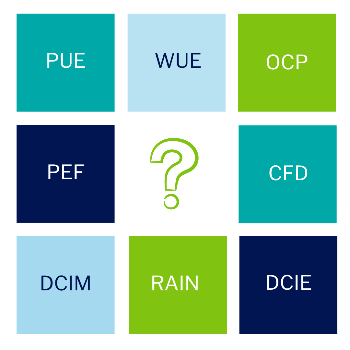IBC 2025 | Meet us in Amsterdam from 12 to15 september 2025

Decoding Green IT: A Comprehensive Guide to Key Definitions and Acronyms
05 February 2024
SED UT TUM
DRM (Digital Rights Management)
In recent years, the IT industry has witnessed a significant shift towards sustainability and environmental responsibility. This transition has given rise to a multitude of terms and acronyms within the realm of Green IT.
This article aims to decode and elucidate the key definitions associated with the green IT landscape, shedding light on concepts like Power Usage Effectiveness (PUE), Water Usage Effectiveness (WUE), Open Compute Project (OCP), and Product Environment Footprint (PEF). Additionally, we'll explore new acronyms that have become commonplace in the ever-evolving world of data centers.
PUE (Power Usage Effectiveness)
PUE stands as a cornerstone metric in the green IT lexicon. Developed by the Green Grid consortium, PUE measures the efficiency of a data center's energy utilization. Expressed as a ratio, PUE represents the total energy consumed by a data center divided by the energy consumed by its IT equipment. A lower PUE signifies higher energy efficiency, with values approaching 1.0 considered optimal.
WUE (Water Usage Effectiveness)
WUE is an emerging metric that addresses the water consumption of data centers, crucial in regions grappling with water scarcity. Similar to PUE, WUE is calculated by dividing the total water consumption by the IT equipment's water usage. Minimizing WUE ensures sustainable water management in data center operations, promoting eco-friendly practices.
OCP (Open Compute Project)
The Open Compute Project, spearheaded by Facebook, promotes open-source designs for data center hardware. OCP aims to enhance energy efficiency, reduce costs, and foster innovation in data center infrastructure. Adopting OCP-compliant hardware allows organizations to embrace sustainable practices by utilizing modular, energy-efficient components.
PEF (Product Environment Footprint)
PEF measures the environmental impact of a product throughout its lifecycle, encompassing raw material extraction, manufacturing, transportation, use, and disposal. In the context of Green IT, PEF is a vital metric for evaluating the sustainability of IT equipment, encouraging the development and adoption of eco-friendly technologies.
DCIE (Data Center Infrastructure Efficiency)
DCIE, or Data Center Infrastructure Efficiency, is a metric that measures the efficiency of a data center by assessing the ratio of useful information technology output to the total energy consumed by the entire data center infrastructure. It is expressed as a percentage, with higher values indicating more efficient use of energy resources in supporting IT operations within the data center.
CFD (Computational Fluid Dynamics)
CFD simulations assist in designing efficient airflow and cooling systems within data centers, reducing energy consumption and enhancing performance.
Conclusion
As the IT industry continues to evolve, the language surrounding Green IT becomes increasingly nuanced. Understanding key definitions is crucial for organizations striving to build sustainable, eco-friendly IT infrastructures. Furthermore, staying abreast of new acronyms such as CFD, DCIM, and RAIN is essential for navigating the ever-changing landscape of data centers with a focus on environmental responsibility. Embracing these concepts and acronyms is not just a trend; it's a commitment to a greener, more sustainable future for the IT industry.
